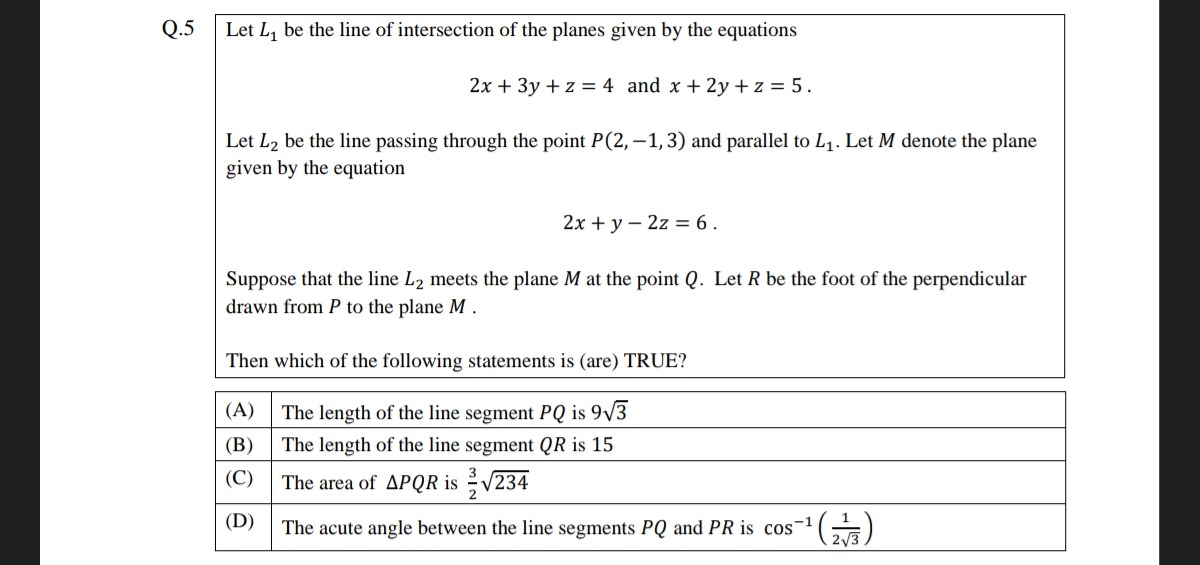Question
Question: Let $L_1$ be the line of intersection of the planes given by the equations $2x + 3y + z = 4$ and $x ...
Let L1 be the line of intersection of the planes given by the equations 2x+3y+z=4 and x+2y+z=5.
Let L2 be the line passing through the point P(2,−1,3) and parallel to L1. Let M denote the plane given by the equation
2x+y−2z=6.
Suppose that the line L2 meets the plane M at the point Q. Let R be the foot of the perpendicular drawn from P to the plane M.
Then which of the following statements is (are) TRUE?

The length of the line segment PQ is 93
The length of the line segment QR is 15
The area of △PQR is 23234
The acute angle between the line segments PQ and PR is cos−1(231)
(A), (C)
Solution
The line L1 is the intersection of the planes 2x+3y+z=4 and x+2y+z=5. The direction vector of L1 is the cross product of the normal vectors of the two planes: v1=(2,3,1)×(1,2,1)=i21j32k11=(3−2)i−(2−1)j+(4−3)k=(1,−1,1).
The line L2 passes through P(2,−1,3) and is parallel to L1. So, the direction vector of L2 is (1,−1,1). The parametric equation of L2 is r(s)=(2,−1,3)+s(1,−1,1)=(2+s,−1−s,3+s).
The plane M is given by 2x+y−2z=6. The point Q is the intersection of L2 and plane M. Substitute the coordinates of a point on L2 into the equation of M: 2(2+s)+(−1−s)−2(3+s)=6 4+2s−1−s−6−2s=6 −3−s=6⟹s=−9. Substitute s=−9 into the equation of L2 to find Q: Q=(2+(−9),−1−(−9),3+(−9))=(−7,8,−6).
The length of PQ is the distance between P(2,−1,3) and Q(−7,8,−6): PQ=(−7−2)2+(8−(−1))2+(−6−3)2=(−9)2+92+(−9)2=81+81+81=3⋅81=93. Statement (A) is TRUE.
R is the foot of the perpendicular from P(2,−1,3) to the plane M:2x+y−2z=6. The line through P perpendicular to M has the direction vector equal to the normal vector of M, nM=(2,1,−2). The parametric equation of this line is r(t)=(2,−1,3)+t(2,1,−2)=(2+2t,−1+t,3−2t). Substitute the coordinates into the equation of M to find R: 2(2+2t)+(−1+t)−2(3−2t)=6 4+4t−1+t−6+4t=6 −3+9t=6⟹9t=9⟹t=1. Substitute t=1 to find R: R=(2+2(1),−1+1,3−2(1))=(4,0,1).
The length of QR is the distance between Q(−7,8,−6) and R(4,0,1): QR=(4−(−7))2+(0−8)2+(1−(−6))2=112+(−8)2+72=121+64+49=234. Statement (B) says QR=15, which is false.
The area of △PQR can be calculated using the coordinates of P,Q,R. Since R is the foot of the perpendicular from P to the plane containing Q and R, the line segment PR is perpendicular to the plane M. The line segment QR lies in the plane M. Therefore, PR is perpendicular to QR. △PQR is a right-angled triangle with the right angle at R. The area of △PQR=21⋅QR⋅PR. We have QR=234. The length of PR is the distance between P(2,−1,3) and R(4,0,1): PR=(4−2)2+(0−(−1))2+(1−3)2=22+12+(−2)2=4+1+4=9=3. Area of △PQR=21⋅234⋅3=23234. Statement (C) is TRUE.
The acute angle between PQ and PR is the angle ∠RPQ. In the right-angled triangle △PQR, this angle is ∠P. We have PR=3 (adjacent side) and PQ=93 (hypotenuse). cos(∠RPQ)=PQPR=933=331. Statement (D) says the acute angle is cos−1(231), which is false.
The true statements are (A) and (C).
